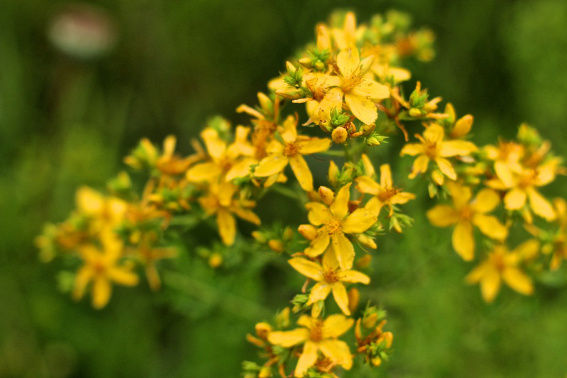St. John's Wort - Medicinal Magic
- Sarah Dafoe

- Jul 13, 2022
- 4 min read
There are two types of plants known as St. John's Wort, one is an ornamental variety with it's large flower heads and spreading form considered to be slightly invasive and found in many garden landscapes, the other is a scrawny looking plant growing on the side of roadways and in disturbed soil sites. This plant has much smaller flower heads and is considered by many to be a weed, but the medicine it holds is so strong that it has been called magical, due to the vibrant red colour which comes out of its very yellow blossoms! Worked with for depression, burns and nerve damage it's Latin name is Hypericum perforatum and it is everywhere this time of year.

Often blooming around the summer solstice, St. John’s Wort has a poetic and complex relationship with the sun. Its bright yellow blooms will stain your fingers red when crushed, which is one reason why its common name pays homage to the Christian martyr, St. John.
'A red color from yellow flowers? If that’s not magic, I don’t know what is.'
- Henriette Kress.
St. Johns' Wort has been worked with since ancient times in Europe and was often associated with the magical world of fairies, witches, and saints. In the book, Native American Ethnobotany, the author lists several native species that were worked with by First Nations people for wounds, diarrhea, aching feet, sore eyes, and weak lungs. Externally, it was applied in Medieval times to sword or knife wounds as part of a regimen for analgesic, healing, and disinfectant purposes. Also, it was chosen to assist children and teens through their growing pains.
In modern times, St. John’s Wort is often pigeon-holed as the “depression” herb. Its potency will put it off the table for individuals taking medication but for individuals nearing the point of seeking medical intervention it can indeed change the course for the better. It accomplishes this with regular consumption by targeting the neurotransmitters of the digestive system/gut brain and altering serotonin levels with results like that of pharmaceutical SSRI antidepressants.
While there are an impressive number of clinical trials focusing on the plant for seasonal depression, trauma (mental, emotional, or physical) and grief, for many herbalists, St. John’s Wort is only a minor herb for depression. A more thorough review shows that this potent plant shines in many areas, including offering powerful pain relief, healing wounds, and supporting liver health.

Applied externally it is absorbed through the skin and does not act on the liver, it's vulnerary action helps the skin to regenerate and heal wounds and injuries, mend localized nerve damage, absolve skin conditions, and sooth overused joints and muscles. Poultice, alcohol extract, cream, and oil are common means by which SJW can mend maladies topically. It is trusted to halt degenerative soft tissue troubles and spark regeneration with consistent application. Pure decoctions can likewise be applied in the mouth for sores or toothaches.
St. John’s wort can be infused into oil at home and makes a superb massage oil for tense, sore muscles, and also helps with minor burns, stopping the pain and healing the burn. The trick to working with St. John’s Wort oil for burns is to apply it to the burn right away. Get a bowl or basin, and soak the burned area, or use an oil-soaked muslin cloth and keep it applied to the area for one hour. Apply it several times during the first day of being burned.
Saint John’s Wort (Hypericum perforatum) Monograph Family: Hypericaceae, Hypericum

Habitat & Habit: This hardy 1-3 foot perennial has small, sunny yellow blossoms and its stems excrete a red/purple liquid known as “the blood of St John” and was historically used for dye. “Perforatum” refers to the leaves’ tiny “perforations” that are actually oil glands which can be seen when viewed up close against the sun. It is semi-evergreen and prefers sunny, well-draining, and temperate conditions to thrive.
Energetics: Warming, drying, sweet, and bitter
Indications:
Joint, muscle, tooth, and nerve afflictions (including sciatica, neuralgia, pinched or damaged nerves; injuries)
Chronic inflammatory states, stagnations, poor digestion (ulcers, depleted liver function, constipation, nervous tummy), and toxic burden
Depression, anxiety, seasonal affective disorder (SAD), serotonin/neurotransmitter disorders, ADD/ADHD
Skin lesions, wound protection and healing, acne, rashes
Female reproductive and hormonal afflictions
Hypothyroidism and sluggishness in general
Hepatitis, herpes, chickenpox, and flu strains
Constituents: Flavonoids, phloroglucinols (hypericin), polycyclic diones (hyperforin), tannins, glycosides, carotene, pectin, and more
Actions: Trophorestorative, anti-inflammatory, anti-depressant, healing, diuretic, anti-viral, vulnerary, antiolytic, nervine, disinfectant, relaxant, digestive, neuroprotective, hepatic, alterative, anodyne, exhilerant
Contraindications: SJW is such a strong hepatic it will likely cause the liver to essentially kick out any drugs taken with the herb so if one is taking any drugs – especially life saving drugs, psychiatric medication, or contraceptives – it is essential not to take this internally. Also, anyone with photosensitivity may experience exacerbated reactions when taking this herb. People with rosacea should similarly avoid it.
Preparations: Tea, tincture, elixer, oil, topical ointments
Harvesting and Preserving
Harvest St. John's Wort flowers once the buds have fully opened, roughly chop them and fill a glass jar with them 2/3 of the way up. Add your choice of oil and fill the jar all the way to the top, place in a cool location and shake daily for a week, then once a week for six weeks. Remember to label the jar with the date and type of oil. After six weeks strain off the plant material and you will be left with a bright red oil, ready to work with for various skin and muscle issues. Will last about six months.









Comments